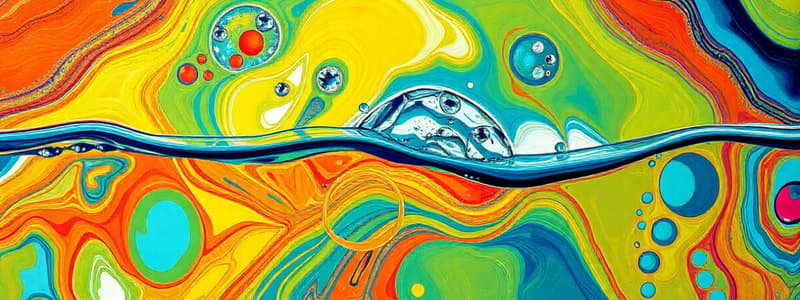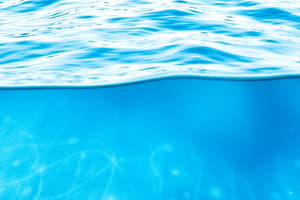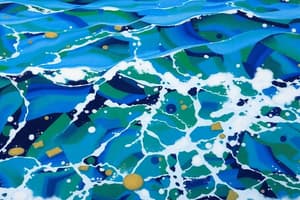Podcast
Questions and Answers
What property of water allows it to absorb a lot of energy without a significant increase in temperature?
What property of water allows it to absorb a lot of energy without a significant increase in temperature?
- Moderating temperature (correct)
- Solvation
- Density
- Cohesion
Ice sinks in water due to its greater density.
Ice sinks in water due to its greater density.
False (B)
What term describes substances that can dissolve easily in water?
What term describes substances that can dissolve easily in water?
hydrophilic
Water expands upon freezing due to the formation of a _________ structure.
Water expands upon freezing due to the formation of a _________ structure.
Match the following biological monomers with their classes:
Match the following biological monomers with their classes:
Which of the following pH levels is considered normal for blood?
Which of the following pH levels is considered normal for blood?
What is the main component of blood that is more than 90% water?
What is the main component of blood that is more than 90% water?
Organic molecules contain ________ as a primary element.
Organic molecules contain ________ as a primary element.
What are nonprotein molecules that assist enzyme catalysis called?
What are nonprotein molecules that assist enzyme catalysis called?
Enzymes are consumed in the reactions they catalyze.
Enzymes are consumed in the reactions they catalyze.
What is the primary role of ATP in cells?
What is the primary role of ATP in cells?
The process of _____ involves making a new copy of DNA.
The process of _____ involves making a new copy of DNA.
Match each type of RNA with its function:
Match each type of RNA with its function:
Which of the following is a characteristic of enzymes?
Which of the following is a characteristic of enzymes?
All DNA bases are purines.
All DNA bases are purines.
What are the building blocks of nucleic acids?
What are the building blocks of nucleic acids?
A change in the nucleotide sequence of DNA is known as a _____ .
A change in the nucleotide sequence of DNA is known as a _____ .
In which cellular reactions is ATP produced?
In which cellular reactions is ATP produced?
What type of bond is formed when monosaccharides are joined together in carbohydrates?
What type of bond is formed when monosaccharides are joined together in carbohydrates?
Glycogen is a polysaccharide that serves as a storage molecule in plants.
Glycogen is a polysaccharide that serves as a storage molecule in plants.
What is the monomer of carbohydrates?
What is the monomer of carbohydrates?
Fats that are solid at room temperature are called ___________ fats.
Fats that are solid at room temperature are called ___________ fats.
Match the following types of proteins with their descriptions:
Match the following types of proteins with their descriptions:
Which of the following is NOT a type of lipid?
Which of the following is NOT a type of lipid?
Humans can digest cellulose due to the presence of the necessary enzyme.
Humans can digest cellulose due to the presence of the necessary enzyme.
What is the function of cholesterol in biological membranes?
What is the function of cholesterol in biological membranes?
A compound with both hydrophilic and hydrophobic parts is termed _____________.
A compound with both hydrophilic and hydrophobic parts is termed _____________.
Match the following lipids with their characteristics:
Match the following lipids with their characteristics:
What determines the primary structure of proteins?
What determines the primary structure of proteins?
The secondary structure of proteins is stabilized by covalent bonds.
The secondary structure of proteins is stabilized by covalent bonds.
What are the three functional groups attached to the central carbon of amino acids?
What are the three functional groups attached to the central carbon of amino acids?
When proteins lose their structure and become biologically inactive, they are said to be _____________.
When proteins lose their structure and become biologically inactive, they are said to be _____________.
Flashcards are hidden until you start studying
Study Notes
Water Properties
- Cohesion allows water molecules to stick together, enhancing surface tension.
- Water moderates temperature, absorbing significant energy before warming; it helps maintain stable environmental temperatures and plays a role in sweating.
- Water expands upon freezing due to hydrogen bonds forming a lattice structure, causing ice to float and providing insulation for aquatic life during winter.
- Being a polar molecule, water effectively dissolves polar and charged substances, known as hydrophilic; oils and lipids are examples of hydrophobic substances.
- Buffers maintain pH levels, crucial for blood, which must remain between 7.35-7.45. Water composes over 90% of blood.
Organic Molecules and Functional Groups
- All matter, including living organisms, follows chemical and physical laws, leading to complex molecules known as organic compounds, primarily made of carbon.
- Organic molecules consist of carbon skeletons connected by covalent bonds, forming hydrocarbons when only carbon and hydrogen are present.
- Functional groups attached to carbon skeletons dictate unique chemical properties, influencing cellular function such as those in steroid hormones.
- Biological molecules are complex with many composed of polymers formed from monomers, categorized into four classes: carbohydrates, lipids, proteins, and nucleic acids.
Carbohydrates
- Composed of carbon, hydrogen, and oxygen, making up 2-3% of total body mass.
- Monosaccharides are the simplest sugars and serve as monomers for carbohydrates, linked by dehydration synthesis to form more complex forms like disaccharides and polysaccharides.
- Glycogen serves as the primary storage polysaccharide in animals, while starches serve this role in plants; cellulose is indigestible in humans due to lack of the necessary enzyme.
Lipids
- Lipids are hydrophobic molecules primarily made of carbon and hydrogen, representing 18-25% of body mass in humans.
- Types include fatty acids, triglycerides, phospholipids, steroids, eicosanoids, and fat-soluble vitamins.
- Fatty acids vary by saturation: saturated fatty acids have no double bonds, while unsaturated have one or more double bonds.
- Triglycerides are three fatty acids bonded to glycerol; they can be solid (fats) or liquid (oils) at room temperature.
- Phospholipids are amphipathic, essential for biological membranes, with hydrophilic phosphate heads and hydrophobic tails.
- Steroids, built from four fused carbon rings, include cholesterol, which is vital for membrane fluidity.
Proteins
- Proteins are large structures comprising carbon, hydrogen, oxygen, and nitrogen, contributing 12-18% of total body mass and determining tissue structure.
- Amino acids are the building blocks of proteins, linked by peptide bonds formed through dehydration synthesis.
- Protein structure is hierarchical: primary (amino acid sequence), secondary (folds formed by hydrogen bonding), tertiary (three-dimensional shape), and quaternary (arrangement of multiple polypeptides).
- Denaturation leads to loss of structure and function.
- Enzymes act as biological catalysts, enhancing reaction rates without consumption and requiring specific substrates.
Nucleic Acids
- Composed of carbon, hydrogen, oxygen, nitrogen, and phosphorus, existing as DNA or RNA.
- DNA contains genes, which are regions specifying proteins, and undergoes transcription to form RNA, which is then translated into proteins.
- Nucleotides are the monomers, consisting of nitrogenous bases (A, T, C, G for DNA and A, U, C, G for RNA), a pentose sugar, and a phosphate group.
- DNA forms a double helix due to base pairing, with mutations arising from sequence changes.
- RNA plays various roles in cellular processes, including mRNA, rRNA, and tRNA.
- ATP serves as the energy currency in cells, generated through cellular respiration and hydrolysis, releasing energy when phosphate bonds are broken.
Studying That Suits You
Use AI to generate personalized quizzes and flashcards to suit your learning preferences.




